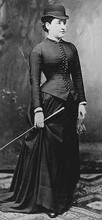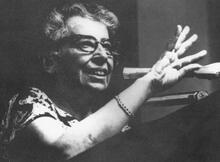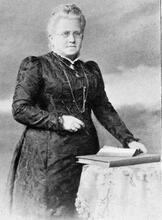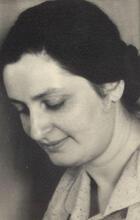Jewish Mothers of the Plaza de Mayo
The Mothers of the Plaza de Mayo were a powerful social movement in Argentina who have fought for human rights since the 1976-1983 dictatorship. Jewish women played a pivotal role in this movement, demanding truth and justice for their children and everyone impacted by the military government, which disappeared, tortured, and killed an estimated 30,000 people. As Jewish mothers, their stories resonate with Jewish histories of violence, migration, and activism, revealing the complexities of establishing belonging and citizenship in the Americas.
Introduction
During years of profound state terror in Argentina, mothers whose children were “disappeared” by the government—kidnapped in a clandestine manner, leaving no trace of their whereabouts—joined together in the central public square to protest. The Mothers of the Plaza de Mayo became a powerful movement for justice and human rights—and many of those women were Jewish.
They began their marches in the midst of the civic-military dictatorship that ruled from 1976 to 1983, a period of widespread state terrorism and repression, with death squads systematically kidnapping, torturing, and killing individuals considered to be “subversive” to the national order. These years of dictatorship have been called the Dirty War, the “proceso” (for Process of National Organization), and more recently, genocide. Up to an estimated 30,000 people were tortured and killed in those years, including students, priests, psychologists, teachers, and members of labor unions and protest movements. An estimated twelve percent of those victims were Jewish—a high number, as Jews represented only an estimated one percent of the population as a whole. Though not necessarily targeted for being Jewish, many suffered antisemitism during torture. Jewish Argentines, however, were also quite active in the human rights movements that rose up to challenge the dictatorship.
A Visible and Powerful Force
At the height of state terror, when many feared that any form of dissent would expose them to disappearance or repression, the Mothers began demanding to know what happened to their missing children, and that they be returned alive. They made their first public protest in April 1977, standing in the Plaza de Mayo, a public square facing the Casa Rosada (Presidential Palace) that symbolizes the heart of Argentina. They wore simple white headscarves stitched with the names of their children and the date they were disappeared. Many also held posters with photographs of their children, symbolically refusing to let them disappear. At first, being mothers protected them in some ways, with the authorities leaving them alone. Many of them were housewives with no prior political experience, whom the government dismissed as “locas” (crazy). However, after drawing international attention to the human rights abuses in Argentina, the women became targets for repression. Despite the pervasive terror in which they lived, they continued, returning to the Plaza every Thursday, becoming a powerful social movement and one of the only visible public forms of protest during those years of terror and fear.
Because of differences in thinking about strategy and stances towards the government, the original movement eventually split into two groups: the Mothers of the Plaza de Mayo Association and the Mothers of the Plaza de Mayo, Founding Line. Yet both remained in the Plaza, even after democracy came to Argentina in 1983. Their Thursday protests continued, an important way to challenge the amnesty granted to perpetrators and advocate for memory and justice.
An Opportunity for Activism
For Jewish members, the group’s prominence represented an important moment of citizenship and activism. The Jewish community in Argentina is the largest in Latin America, representing about 200,000 people with a rich cultural history that includes literature and theater and a vibrant network of schools, synagogues, and community centers. Primarily Jews of European origin and their descendants, including most of North and South American Jewry.Ashkenazi, the majority of these Jews came from families who emigrated from Europe in the late nineteenth century, fleeing pogroms and poverty. They were followed by waves of Jews leaving Europe during the rise of Nazism, and later by Holocaust survivors.
However, in the aftermath of World War II, Argentina also welcomed many former Nazis, including the notorious Adolf Eichmann, a major organizer of “the final solution,” who lived in hiding until he was captured in 1961 to stand trial in Jerusalem. This underscores how despite their long-established presence in Argentina, Jews were plagued by antisemitism and other forms of persecution during the period of military dictatorship, as well as later, in the early 1990s, when Argentina suffered two terrorist attacks that have remained in a state of impunity as of this writing.
In response, activism proved vital, and Jewish Argentines participated in substantial ways in various human rights movements, to help build civil society and protect the values of democracy and justice central to all of Argentina. The years of dictatorship saw many instances of advocacy and dissent, such as writing for publications like Nueva Presencia (New Presence) and participating in the Assembly for Human Rights and the Jewish Movement for Human Rights. The Mothers of the Plaza de Mayo stands apart as the most visible form of public protest during that time.
Notable Jewish Mothers of the Plaza de Mayo
Below are brief profiles of Jewish mothers whose children were disappeared during the 1976-1983 dictatorship. Like all Mothers of the Plaza de Mayo, these women fought to find their children and advocated for the return of all of the disappeared. In addition, as Jewish mothers, they had histories marked by antisemitic violence, migration, and activism. Their profiles reveal some of the challenges they faced in trying to find belonging and secure their lives in the Americas.
Renée Epelbaum was a founding member of the Mothers of the Plaza de Mayo (Founding Line). She was born in Argentina’s Entre Rios Province to Jewish parents who emigrated from Russia and married a man whose parents were Polish Jews. All three of her children were disappeared during the dictatorship. Her son Luis, aged 26, disappeared in 1976, kidnapped while leaving his university in Buenos Aires where he was studying medicine. Her other two children–Claudio, a 23-year-old law student, and Lila, a 21-year-old dancer–were disappeared in 1976 as well, from a home in Uruguay where she thought they would be safer. After their disappearance, she helped form the Mothers of the Plaza de Mayo and began protesting to advocate for her children and the many others disappeared by the government. She also raised awareness by advocating with local community groups, including the Argentine Jewish community organization DAIA (Delegación de Asociaciones Israelitas Argentinas, or Delegation of Jewish Argentine Associations). Until her death in 1998, Epelbaum continued to devote her life to bringing international attention to the plight of the disappeared and the human rights violations committed in Argentina. In addition to testifying before the United Nations, she fought to repeal the amnesty laws instituted after the end of the dictatorship.
Sara Silberg de Brodsky was a member of the Mothers of the Plaza de Mayo (Founding Line) whose son Fernando was disappeared in 1979 and taken to the infamous torture center at the ESMA (the School of Naval Mechanics). Brodsky’s activism also extended to other organizations within the Argentine human rights movement network. In 1982, she co-founded the Jewish Movement for Human Rights with Jewish Argentine activist Herman Schiller and Rabbi Marshall Meyer, a North American rabbi who brought Conservative Judaism to Argentina and later served as a member of the post-dictatorship CONADEP Truth Commission. Later, she also co-founded the Association of Family Members of Jewish Disappeared. Like many Mothers, Brodsky continued advocating for justice and truth throughout her life, offering testimony in both the 1985 Trial of the Juntas and the ESMA megatrial, which concluded in 2017 after finding 29 perpetrators guilty of human rights abuses. Her son Marcelo Brodsky, a renowned photographer, used his art to commemorate the disappearance of his brother Fernando, including a visual essay entitled Buena Memoria (Good Memory). This essay incorporates artistic work by Sara, including a sculpture she made of Fernando that appears with a menorah, emphasizing the significance of Jewish traditions for his family during those years.
Matilde Mellibovsky, a member of the Mothers of the Plaza de Mayo (Founding Line), was the mother of Graciela, who disappeared in 1976. After her disappearance, Mellibovsky joined the Jewish Movement for Human Rights in addition to advocating for her daughter through the Mothers. Her important book, Circle of Love Over Death (originally published in Spanish in 1990 and then translated into English), is a compilation of testimonies and one of the first explorations of the lived experiences of the disappeareds’ family members.
When Mellibovsky died in 2011, the Mothers held a symbolically powerful ceremony for her at the Park of Memory, scattering her ashes in the infamous River Plate, where some of the disappeared were thrown from planes in “death flights” after being drugged and tortured. Her legacy would live on through her book, which helped to create a public space for mothers and other family members of the disappeared to bear witness to their loss.
Member of the Mothers of the Plaza de Mayo Vera Jarach speaking with German chancellor Angela Merkel at the Parque de Memoria, 2017.
Vera Vigevani de Jarach, born in 1928 in Milan, Italy, emigrated to Argentina in 1939 with her family to escape the rise of Nazism and fascism. Her daughter Franca was disappeared in 1976, compelling Jarach to begin advocating as a Mother of the Plaza de Mayo (Founding Line). After Franca vanished, some reported seeing her at the ESMA torture center; only recently it was determined that she died during a “death flight.” Since Franca’s disappearance, Jarach has advocated tirelessly for her daughter, seeking information through many channels, including her work as a journalist for the ANSA (Argentine national news agency) as well as through Amnesty International, the Italian Embassy, and the Red Cross. Jarach continued her advocacy after the end of the dictatorship, also working with the Fundación Memoria Histórica y Social Argentina (Historical and Social Memory Foundation) and the Park of Memory, as well as with Italian organizations. She testified in 2016 about the importance of telling her story in the schools, in hopes that direct dialogues with students would generate solidarity and change, as well as the active critical thinking that she considers central to democracy.
Like many other Mothers, Jarach tirelessly advocated for the memory of all the disappeared. In 2017, during a ceremony at the Park of Memory, she approached German Minister Angela Merkel, wearing the iconic white headscarf of the Mothers and a sign reading “They are 30,000” (the number of disappeared). Identifying herself as an Italian Jew, she described escaping Italy after the racial laws were imposed. Her grandfather stayed behind and was later killed at Auschwitz. She told Merkel that there was no grave for him, and many years later, when her 18-year-old daughter was disappeared and then tortured and killed in an Argentine concentration camp, there was no grave for her either. By continuing to fight for justice and memory, she went on, the Mothers were trying to prevent the denial and revisionism about the past that represents another form of violence. In addition to the key goals for human rights movements in Argentina—memory, justice, and truth—Vera noted that she had a fourth appeal for all of humanity: “Never Again Silence.”
Member of the Mothers of the Plaza de Mayo Sara Rus speaking about the disappearance of her son Daniel, 2014.
Sara Rus, a member of the Mothers of the Plaza de Mayo (Founding Line), was born in Lodz, Poland. She survived the Holocaust, first in the Lodz Ghetto, and later the Auschwitz-Birkenau and Mauthausen concentration camps. She emigrated to Argentina in 1948. Her son Daniel Lázaro Rus was disappeared in 1977, taken while he was at work as a scientist at Argentina’s Atomic Energy Commission. Before his disappearance, Sara and her husband Bernardo, knowing that his friends and colleagues were being targeted, had urged their son to leave the country for Uruguay, but he had refused. From the moment he disappeared, they searched everywhere, appealing to the Interior Ministry and various government and international entities, all to no avail.
Like the other Mothers, Rus continued her activism after the fall of the dictatorship, giving testimony at schools and traveling to share her experiences as someone who “survived twice.”
Losing her son was a terrible blow that she never imagined happening. Having survived the Holocaust, she had believed that she and her family were “living in a better world, a free world,” only to discover that she was living in a world ruled by a military that “tortured and killed people in the same way as the Nazis…. This could never be forgotten” (2014 interview). Her story is chronicled in a 2007 biography by Eva Eisentaedt, published in Argentina.
An International Model
As Mothers of the Plaza de Mayo, these Jewish women helped create one of the most important human rights movements in Argentina. Ordinary women without much political experience joined together to fight for their children, who had been disappeared by a repressive state. Their work has been part of an important network of human rights advocacy in Argentina, including other movements, like the Grandmothers of the Plaza de Mayo (whose work focuses on locating their grandchildren, born to parents detained during the years of state terror), the Jewish Movement for Human Rights, and the important CELS (Center for Legal and Social Studies in Argentina). Many Mothers have participated in efforts for transitional and retributive justice, including the Trial of the Juntas (1985), and more recently the mega-ESMA trial (2012-2017). Their testimony before the landmark Truth Commission (the CONADEP) is documented in the 1984 report, Nunca Más (Never Again), and they have stood in solidarity with other Argentine justice movements, including those investigating the 1994 AMIA (Asociación Mutual Israelita Argentina or Argentine Jewish Mutual Aid Society) terrorist bombing.
The story of the Jewish Mothers also reveals how the violence in Argentina resonated with other atrocities, including the Holocaust. Throughout its existence, the group has received support from around the world and from others within the Jewish diaspora. With their weekly Thursday marches, the Mothers movement became a powerful symbol of resistance and social justice in Argentina, showing how ordinary citizens can stand up to a repressive state and build a democratic civil society.
Bouvard, Marguerite Guzman. Revolutionizing Motherhood: The Mothers of the Plaza de Mayo. Wilmington, DE: Scholarly Resources, 1994.
Brysk, Alison. The Politics of Human Rights in Argentina: Protest, Change, and Democratization. Stanford, CA: Stanford University Press, 1994.
Eisenstaedt, Eva. Sobrevivir dos Veces: De Auschwitz a Madre de Plaza de Mayo; Relato Testimonial de Sara Rus. Buenos Aires: Editorial Milá, 2007.
Elkin, Judith Laikin. The Jews of Latin America. 3rd ed. New York, NY: Holmes & Meier, 2014.
Falbel, Rita. “Renee Epelbaum: Still Struggling for Truth and Justice in Argentina.” Bridges 1, 1 (1990): 86-95.
Fisher, Jo. Mothers of the Disappeared. Boston, MA: South End Press, 1989.
Kahán, Emmanuel Nicolás. Memories That Lie a Little: Jewish Experiences during the Argentine Dictatorship. Translated by David Foster. Leiden: Brill, 2019.
Mellibovsky, Matilde. Círculo de amor sobre la muerte. Buenos Aires: Ediciones del Pensamiento Nacional, 1990.
Mellibovsky, Matilde. Circle of Love over Death: Testimonies of the Mothers of the Plaza de Mayo. Translated by Maria and Matthew Proser. Willimantic, CT: Curbstone Press, 1997.
Navarro, Marysa. “The Personal is Political: Las Madres de Plaza de Mayo.” In Power and Popular Protest: Latin American Social Movements, edited by Susan Eckstein, 241-258. Berkeley, CA: University of California Press, 1989.
Partnoy, Alicia. The Little School: Tales of Disappearance and Survival. Translated by Alicia Partnoy with Lois Athey and Sandra Braunstein. San Francisco, CA: Midnight Editions, 1998 [1986].
Robben, Antonius C.G.M. Political Violence and Trauma in Argentina. Philadelphia, PA: University of Pennsylvania Press, 2005.
Schirmer, Jennifer G. “‘Those who die for life cannot be called dead’: Women and Human Rights Protest in Latin America.” Feminist Review, Vol. 32 (1989): 3–29.
Strejilevich, Nora. A Single Numberless Death. Translated by Cristina de la Torre with collaboration of author. Charlottesville, VA: University of Virginia Press, 2002.
Taylor, Diana. Disappearing Acts: Spectacles of Gender and Nationalism in Argentina’s “Dirty War.” Durham, NC: Duke University Press, 1997.
Timerman, Jacobo. Prisoner without a Name, Cell without a Number. Translated by Tony Talbot. New York, NY: Vintage Books, 1981.
Verbitsky, Horacio. The Flight: Confessions of an Argentine Dirty Warrior. Translated by Esther Allen. New York, NY: New Press, 1996.
Documentary
Las Madres de la Plaza de Mayo (1985), Susana Blaustein Muños and Lourdes Portillo dir.
Additional News and Video Links about the Jewish Mothers of the Plaza de Mayo
For more on RENÉE EPELBAUM, see:
Briley, Harold. “Obituary: Renee Epelbaum.” Independent. February 24, 1998.
https://www.independent.co.uk/news/obituaries/obituary-renee-epelbaum-1…
“Los que confesaron no se arrepienten de nada.” Página/12. March 24, 1995.
https://www.pagina12.com.ar/especiales/30anios/reportajes-renee_epelbau…
Sims, Calvin. “Rene de Epelbaum, 77, Argentine Protester.” New York Times. February 9, 1998.
https://www.nytimes.com/1998/02/09/world/rene-de-epelbaum-77-argentine-…
For more on SARA BRODSKY, see:
Brodsky, Marcelo. Good Memory/Buena Memoria. https://marcelobrodsky.com/good-memory-4-nando-my-brother/?lang=en
“Murió la Madre de Plaza de Mayo Sara Brodsky.” Tiempo Argentino. February 24, 2018.
https://www.tiempoar.com.ar/nota/murio-la-madre-de-plaza-de-mayo-sara-b…
For more on MATILDE MELLIBOVSKY, see:
“Falleció una de las fundadoras de Madres de Plaza de Mayo.” El Patagónico. February 23, 2011. https://www.elpatagonico.com/fallecio-una-las-fundadoras-madres-plaza-m…
For more on VERA JARACH, see:
CELS Parque de la Memoria. 2017. https://www.youtube.com/watch?v=ZrbQRC_PZFo
Vera Jarach. “Testimonio sobre la vida de Franca.” Eduiot Testimonios de Vida. http://eduiot.amia.org.ar/testimonio/franca-jarach/
For more on SARA RUS, see:
CNN Radio Argentina. “Sara Rus, la Madre de Plaza de Mayo sobreviviente de Auschwitz.” June 18, 2019. https://cnnespanol.cnn.com/radio/2019/06/18/sara-rus-la-madre-de-plaza-…
“From Holocaust Survivor to Mother of Plaza de Mayo.” Jewish Journal. August 17, 2016. https://jewishjournal.com/current_edition/189080/
Sara Rus. “Tengo que contar.” 2014. https://www.youtube.com/watch?v=pWsps75ckyI
Sara Rus and Natalia Rus. “Testimonio sobre la vida de Daniel.” Eduiot Testimonios de Vida. http://eduiot.amia.org.ar/testimonio/daniel-lazaro-rus/.










